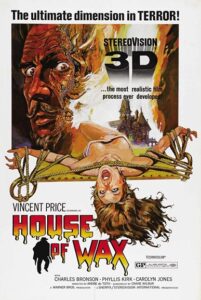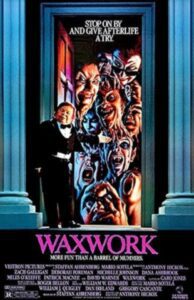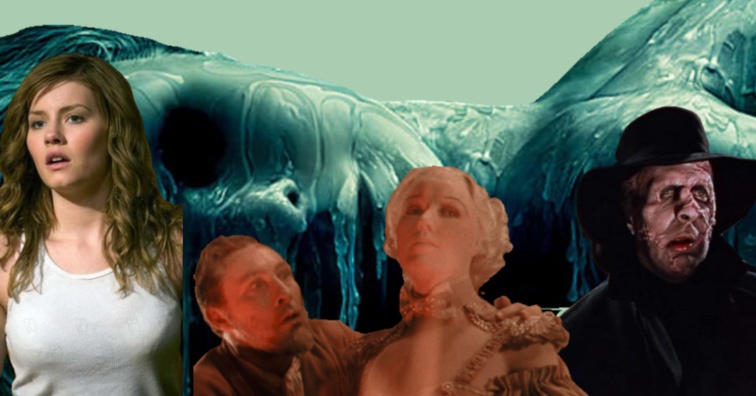House Of Wax Movies – A Full Body Wax Treatment
No matter how you look at it, wax dolls always have a scary side. One can quickly think of reasons for their creepy side: they resemble real people, but not entirely, which creates an inevitable blurring between the real and the artificial. The fact that the figures are frozen, often in some defined position, and the contrast between the dynamics we see in living beings and the sculpture’s static can be frightening. To this, many of the world’s wax museums highlight the scary side, thanks to lighting and sound effects, for example, and the relatively common image of wax dolls resurrected in horror movies.
It is impossible to talk about the presence of wax dolls in horror films and not mention the “House of Wax.” There have been several movies, starting as far back as the 1930s, with almost the same idea but only partially. These films also mark some of the most essential points in Hollywood history, at least technically. Isn’t it time for another wax film?
House Of Was Movies – The Full List
Mystery Of The Wax Museum (1933)

Our journey in the wax museums begins in the period before the Hayes Code (Pre-Code Hollywood), which is also of great importance in terms of the use of sound. This is the period between the beginning of the widespread adoption of sound in films in 1927 and the beginning of the enforcement of the Hayes Code in 1934. For those unfamiliar with the history of cinema, we will briefly say that this is an ethical code of internal censorship designed to make the films that the big studios distribute more moral. Among other things, the code prohibited the presentation of murder scenes that could lead to imitation of life, relationships between people of different races, different methods of crime, sexual deviations, and even sexual relationships between people of other races. This code was in effect for decades, with its enforcement only ceasing in 1967.
In these years, we saw a wave of horror films, which were extreme compared to what we were used to (and looking back, the expectation from the code). “Mystery of the Wax Museum” was directed by Michal Curtiz and produced by Warner Brothers. It was one of the last films made using the Two Color Technicolor technique, considered one of the most influential in the development of color in cinema. In short, the method was based on an additive system of two colors to reproduce the film’s color. They used two projectors that split the light into two separate channels, the first capturing the light in blue-green shades and the other in red-orange shades, and this combination created the color. Of course, the color palette here could have been more extensive compared to the Three Strip Technicolor process that entered the picture starting in the 1930s.
Along with its historical importance, “Mystery of the Wax Museum” is an initial version of the monstrous wax film genre. Based on a short story called “The Wax Works” by Charles Belden, the film takes place in London in the 1920s. The main protagonist is Ivan Igor (Lionel Atwill), a sculptor who runs a failed wax museum. One day his partner, Joe Worth, offers to burn down the wax museum to get the insurance money, and when Igor refuses, he burns down the museum himself and leaves the artist to die in flames. From there, the plot moves to New York 12 years later, presenting a mystery of murders and body thefts. And most of all – murdering people to cover them in wax and turn them into human statues, or at least something like that.
Reviews of “Mystery Of The Wax Museum” were mixed, with some critics noting the lack of uniformity in the plot or simply the fact that it went too far. The film was more successful in European countries than in the United States, became lost for a certain period, and over the years, quite a few attempts tried to restore or recreate it. Among other things, a restored and improved version of the film in color was released in 2021.
House of Wax (1953)

Twenty years after “Mystery of the Wax Museum,” Warner Bros. produced a remake. The film’s director was Andre de Toth, who was asked to make a film in 3D here: although he could not watch films in 3D since he lost one of his eyes at a young age. “House of Wax” from 1953 is considered the first 3D film with stereophonic sound in a regular theater and a major American studio’s first color 3D film.
Here is the cinematic “House of Wax” trailer, from the time when trailers didn’t necessarily show scenes from the film but, on the other hand – didn’t ruin them.
The “House of Wax” is considered “culturally, historically and aesthetically significant,” as the US Library of Congress put it, and it was screened in cinemas in the decades that have passed since then in several variations (among other things, as part of the explosion of 3D films in the 80s). The plot here resembles “Mystery of the Wax Museum.” In the lead role, Vincent Price plays the wax artist who manages to survive a fire, stays alive in a distorted image, and tries to restore his wax museum with a murderous twist that you’ve probably already figured out. Despite the director’s difficulty, the film presented some awe-inspiring 3D scenes for that time, when the viewers saw before their eyes a ping pong ball, can-can dancers, and a figure emerging quickly towards them.
Although in the beginning, the reviews of the film ranged from mediocre to negative, partly due to the unjustified brutality or the limited use of 3D, it gained the status of a cult film over the years. Seventy years later, the film holds 93% positive reviews among critics on Rotten Tomatoes and an imposing score of 7.0 on IMDB, which is known to be quite rare in the horror genre.
Waxwork (1988)

Before you get to the last “House of Wax” movie, you should make a short stop in the 80s. In 1988, the film “WaxWork” was released, a horror comedy by Anthony Hickox (who directed the third film in the “Waxer of the Underworld” series) about a director of a wax museum who uses his works “to release horror into the world.” A group of young people arrive at a strange wax museum and move to another dimension, where the wax sculptures are not exactly sculptures. We have yet to see this movie, but from the description and the trailer, it looks like a horror fan’s delight with lots of humor, gore, and a reflexive awareness of the genre we all love.
The film is loosely based on “WaxWorks,” a 1924 German silent film, rather than the other films we’ve reviewed here.
House of Wax (2005)

We mentioned “WaxWork” for one apparent reason: the plot of “House of Wax” from 2005 combines to a certain extent, elements from both “House of Wax” films and from that film, so you can say that it is a kind of loose combination of both. Do you need clarification? We too, but we’ve already gotten used to horror movies being almost always based on previous movies in one way or another.
In “House of Wax,” directed by the Spanish director Jaume Collet-Serra (“Orphan,” “Jungle Cruise,” “Black Adam”), we meet a group of friends who go to a football game. She decides to stop in the middle of a deserted forest at night (in horror movies, it makes a lot of sense), meets a mysterious man, and finds out the following day that the car won’t start (this is also too common in horror movies). Some of the gang decides to go to an abandoned town, where there is practically nothing except what used to be the “House of Wax Museum,” which has wax sculptures that look a little too real. From that moment on, the young people will fight for their lives against crazy brothers who want to kill them brutally and add them to the museum’s collection.
The truth is that this movie has a lot of things that need to be improved, such as the atmosphere, plot, script, and acting of some of the characters, which explains the not-very-high reviews it received. Critics also did not like that it strayed too far, in its nature and style, from the previous versions of “House of Wax.” At the box office, it was reasonably successful, with revenues of about $70 million worldwide, which is less impressive if you consider that the film’s budget was about $40 million.
Nevertheless, some see “House of Wax” as a must-see film for horror fans; some even say a cult film. For the writer of these lines, it is a kind of “Guilty Pleasure” – and not only from the pleasure of seeing Paris Hilton, this time in a legitimate film and not for adults only, impaled to death. This brief killing scene created much of the buzz around the film, as was evident in one of the film’s marketing ads that invited viewers to “watch Paris die.” It also became quite viral, although not in the dimensions of a sex tape over an hour long (we don’t know why we thought of this comparison).
The film included more or less strange deaths of the secondary characters, mainly wax and stabbing means of one kind or another, and some quite good scares. And, of course, it’s impossible not to mention Elisha Cuthbert, who was at that time a sex symbol and a kind of hit girl who has pretty much disappeared in recent decades.
💀 Killer Deals & Scary Recommendations 💀
🎭 Costumes & Accessories
HalloweenCostumes Fun Costumes Entertainment Earth
🛒 Online Shopping
AliExpress Amazon Walmart Etsy
🧛 Collectibles & Horror Brands
Funko Hot Topic Lego Spirit Halloween
🎢 Attractions & Tours
GetYourGuide Tiqets Viator Klook
📖 Blogs & Horror Sites
Bloody Disgusting iHorror Fangoria
🩸 Disclaimer: Some links are affiliate links. The price stays the same – it just helps keep the site alive 👻
Will The House Of Wax Reopen?
Over the years, there have been several attempts to revive the House of Wax films, which have been with us since the early days of commercial cinema. For example, Tim Burton wanted to produce another version of the House of Wax, this time a musical. Burton planned that this version would star none other than Michael Jackson – we didn’t understand whether as a human figure or one of the wax figures – when, according to reports, Jackson himself was eager to participate in the project. Burton’s idea was ultimately rejected by the studios, unfortunately.
And what about “House Of Wax 2?” Well, no so fast! The writers of the 2005 version, Carey W. and Chad Hayes, said they are not working on a sequel. They came up with the idea of a prequel (prequel film) but were rejected by the studios because “House of Wax” did not do exceptionally well at the box office. We believe that we will not close the door on the wax houses and will still see people murdered to become dolls or wax dolls that are resurrected. Even if it doesn’t happen, we’ll always have Madame Tussauds and other smaller wax museums (like the museum in Barcelona), body exhibitions, and other attractions.
Wanna have a full Wax expreience? Try one of these Was museums!








